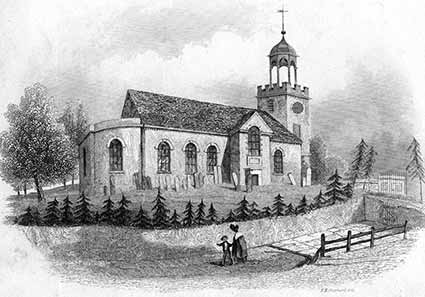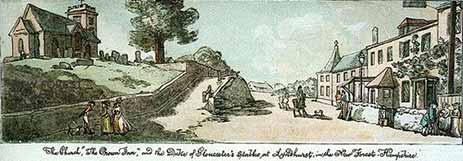Lyndhurst parish church – the earlier church of St. Michael

Richardson, King and Driver on their late-18th century map of the New Forest show a church on the same site as Lyndhurst’s current parish church of St. Michael and All Angels. But the map refers to the present church’s predecessor, which was also dedicated to St. Michael. That had replaced an even earlier, 14th century building sited, maybe, on a Pagan place of worship - the church hillock is said to be a prehistoric man-made mound.
No information survives from Pagan times, and little is known of the 14th century building. But what about the first church of St. Michael?
A relatively modest structure erected in 1741, a sketch of 1784 by Thomas Rowlandson shows it as a fairly rugged, somewhat squat building sitting atop the current hillock, whilst another, probably more realistic, illustration by F.N. Shepherd shows a typically elegant Georgian structure with an equally elegant cupola installed atop the tower.
Its life, though, in Parish Church terms, was relatively short-lived.
By the early 1790s a string and woodwind orchestra accompanied the hymns, but the church was already considered ‘too small to accommodate the increasing inhabitants with proper seating.’ Enlargement proposals at around that time were not, however, progressed.
Mrs. R. Bowden-Smith, grand-daughter of Lady Northesk of Minstead Lodge, lived in Lyndhurst from the 1850s, and recalled asking for use of the family seat in the old church, ‘a large, square pew, quite high, with curtains round it’, being told it was in use by a girls’ school, and having then to use the gallery.
She also left a graphic account of the period of transition from the old church to the current church, revealing a Victorian desire for church ‘improvement’, the influence of local dignitaries, and human nature at its most varied:
‘Sir Charles Burrard and Mr. Lucas (the Curate-in-Charge, who was also Sir Charles’ son-in-law) were very anxious to have a new church but at first there was great opposition to the plan. The tower (of the old church) was voted unsafe and the church very ugly.
In 1858 the demolition began but the building was very strong and the roof very difficult to pull down as it was very well built. Then came the difficulty of extending the space for the foundations of the new church. People whose relations were buried in the churchyard were very angry at the graves being disturbed and some said they would never go to the new church.
I believe the new edifice was begun with only 6,000 pounds …….. We had church services in the school, and Mr. Compton would not allow more to be done until more money was given. (Note: The living was a chapelry, annexed to the rectory of Minstead…in the gift of H. Compton, Squire of Minstead Manor, and held by the Rev. J. Compton. Which of these Comptons held up the works, though, is uncertain).
In 1860 it was consecrated. The roof was supposed to be a temporary one.

a late 18th century print by Thomas Rowlandson
Ladies gave money for the carvings on the pedestals and one after another gift arrived. Once an anonymous gift of several hundreds was sent to Mr. Compton with which to build the tower. Mr. Castleman gave 300 pounds for the clock, Mr. Buckworth Powell gave the bells, Mrs. Aitchison gave the east window in memory of her husband, Mr. Pulteney gave the south window in memory of his parents. The north window is the Powell window.
So bit by bit, the Church has been built, many of the congregation quarrelled about the seats, and some time elapsed before peace was restored.’
Then, writing during the period of construction, local author John Wise had this to say:
‘Close by is the new, half-finished, church, standing in the old churchyard……...
It is not fair at present to pass a final judgment. When the tower is added, and time shall have touched the walls with a soberer tone, its two great defects will have disappeared…….
That there are defects in the church its greatest admirers would admit – the poorness of the roof, the harshness produced by the introduction of so much white, as also the bad colour of the bricks, and a heaviness which hangs over the clerestory windows of the nave.’
And then tellingly, Wise captures what seems to have been the whole spirit of the enterprise:
‘But on the whole, it stands as a proof of the great advance during the last ten years of Art, as a cheering sign, too, that, amidst all the failures of Government, some taste and zeal are to be found amongst private persons.’
The new church was finally completed in 1869, but Mrs. Bowden-Smith noted:
‘After some years the roof became faulty and in 1893 there was a large bazaar and entertainment at Glasshayes (now the Lyndhurst Park Hotel) to raise 1,000 pounds for a new roof. The bazaar did not produce sufficient but the money did come in and the new roof was erected’.
Find out more about the current parish church:
References:
Lyndhurst life 200 years ago: Roy Jackman
Of what I remember of Lyndhurst and the neighbourhood nearly fifty years ago: Mrs. R. Bowden-Smith, courtesy of the Christopher Tower New Forest Reference Library
The New Forest: Its History and Scenery: John R. Wise.
Lyndhurst Historical Society publications: Roy Jackman
More links
Other related links
Search this site

Sadly, 58 animals were killed - 35 ponies, 13 cows, 8 donkeys and 2 sheep, whilst a further 32 were injured - 3 pigs, 9 donkeys, 11 cows and 9 ponies.
(Forty-three accidents occurred in daylight, 15 at twilight and 101 in the dark. Twenty-seven accidents were not reported by the driver involved).
Here's just one horrific example - Three donkeys killed in collision with van at notorious New Forest blackspot (Advertiser and Times)

